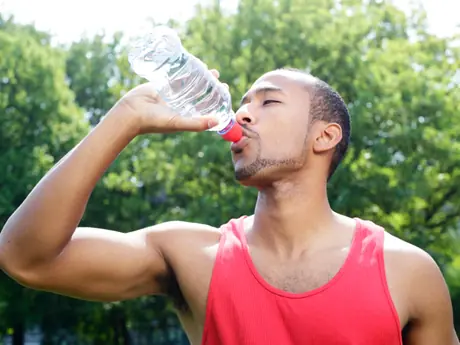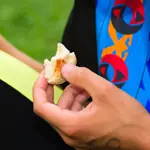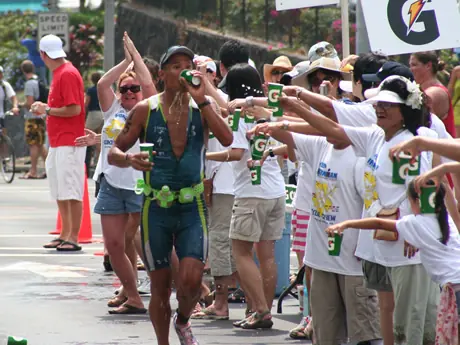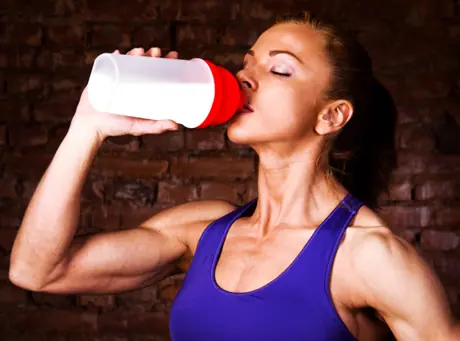Bike
After a personal-best swim, I felt energized for my bike ride. Here's where my normal eating routine changed the most. Instead of eating another gel or bar right away and another full bar an hour in, Rhodes wanted me to drink nothing but water for the next 30 to 60 minutes. She said it's not necessary to consume carbohydrates for energy within that window because the body is using its own glycogen stores for energy. "Your body has a storehouse to store glucose when it's needed on the fly," Rhodes says. "But that's depleted around the 60 to 90 minute mark if you've fueled right the morning of the race and days before."
After that milestone, Rhodes advised me to ingest 45 to 60 grams of carbohydrate per hour, as that's what's needed to provide cells with enough energy to keep going strong.
To accomplish this, it's best to consume high-glycemic foods (e.g., electrolyte drinks, skinless fruit, white bagels) due to them being quickly absorbed by the body. Fiber, fat and protein should be used in minimal amounts at best because each slows absorption of glucose and can cause gastrointestinal stress since more energy is required for digestion. When this happens, "your body is essentially competing for fuel for digestion versus energy for activity," Rhodes says.
To reach the 45- to 60-gram carbohydrate goal through the race's second hour, I added several tablespoons of honey to my electrolyte drink. This got me close to the desired total, and a Honey Stinger waffle (zero protein) got me the rest of the way there. For the final hour of the ride, I drank more honey electrolyte water and downed about half a Bonk Breaker. Since I was new to this eating regimen, I didn't want to go completely without my old stand-by foods. Still, I did not exceed my carb goal.
The result: a personal best by 12 minutes. Again, it's a fast course, but as I prepped in T2 for the run, I felt really good. In fact, my teammate asked me how I was doing when he saw me heading out on the run course and I yelled something positively unprintable. I'm not used to acting that spirited in a 70.3-distance event. I was indeed feeling more-than man-like.
More: How Much Fuel Do You Need During Long Rides
Run
My eating strategy—or lack thereof—on the half marathon was also uncharted territory. Usually I'll consume at least two gels roughly at the 45-minute mark and another gel 30 minutes later. Stone refers to gels as being like 85 octane gas (due to the maltodextrin that slows digestion)—it's OK fuel but if you can put in 91 grade why would you choose anything else?
Stone and Rhodes advised me to stick with nothing but honey and water, snapping open a packet of honey every 15 minutes while gulping water at each aid station.
Two things happened: First, I got frustrated opening the honey packets with sweaty, sunblock-slick hands. Pro-tip: Either pour honey packets into small bottles (mixed with water) like Hammer gel flasks, or cut the edge of each honey packet before the race so you have a grip point to tear. Second, this was the first time I finished a Ironman 70.3 half marathon without stopping or even walking the aid stations. No cramps either, despite the warm weather.
Less than two months prior at Ironman 70.3 Boise, I didn't make it through the first mile without significant leg cramping, and I wound up walking the entire course.
The only area for improvement would be that fatigue set in around mile 10 and my pace slowed. While I was mostly consistent across the entire half marathon, perhaps I should have added more honey, a gel or some cola around mile 8 to aid in the final stretch. Stone and Rhodes also suggested salt and possibly dried bananas as an alternate fuel source.
After only a couple weeks of changing my diet, I've noticed a boost in energy and performance. I'm fighting the proverbial fair fight, though if you had predicted my race results beforehand I'd have thought that maybe somehow I gained a Sparrow-like unfair advantage in order to do it.
More: How to Create Your Ironman Nutrition Plan
 Search for your next triathlon.
Search for your next triathlon.
- 2
- of
- 2









Discuss This Article